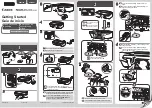
With this numbering system, any combination of the eight pins adds
up to a decimal number between 0 and 255, and no numbers are
duplicated.
Because there are 24 pins in each column, you must make a
calculation for each of the three sections in each column. As you can
see, this method of planning and printing dot graphics requires
considerable calculation. Because triple-density uses 180 columns
per inch, printing a single line of triple-density graphics only one
inch long requires 540 numbers. Fortunately, commercial graphics
software is available to do
these
calculations for you.
Before you can put these numbers into a graphics program,
however, you need to know the format of the graphics command.
The Graphics Command
The graphics mode command is quite different from the other
commands used by the printer. For most of the other printer modes,
such as emphasized and double-wide, one ESC code turns the mode
on and another turns it off. For graphics, the command is more
complicated because the code that turns on a graphics mode also
specifies how many columns it will use. After the printer receives
this code, it interprets the numbers that follow as pin patterns and
prints them on the paper.
Your printer has one command that allows you to use any of the 11
graphics options. The format of the command is:
ESC *
data
4-14
Software and Graphics
Summary of Contents for LQ-1050
Page 1: ......
Page 2: ...EPSON LQ 850 950 1050 User s Manual ...
Page 19: ...4 Remove th 5 Slide the print head to the middle of the printer Setting Up the Printer 1 5 ...
Page 111: ......
Page 230: ...8 Reattach the 6 8 Maintenance ...
Page 330: ...Appendix Proportional Width Table A 2 Character Tables A 6 A l ...
Page 336: ...Epson Extended Graphics Character Table A 7 ...
Page 352: ...EPSON L Q 8 5 0 9 5 0 1 0 5 0 Quick Reference ...
Page 356: ...EPSON Printed in Japan 90 01 40 0 ...
















































